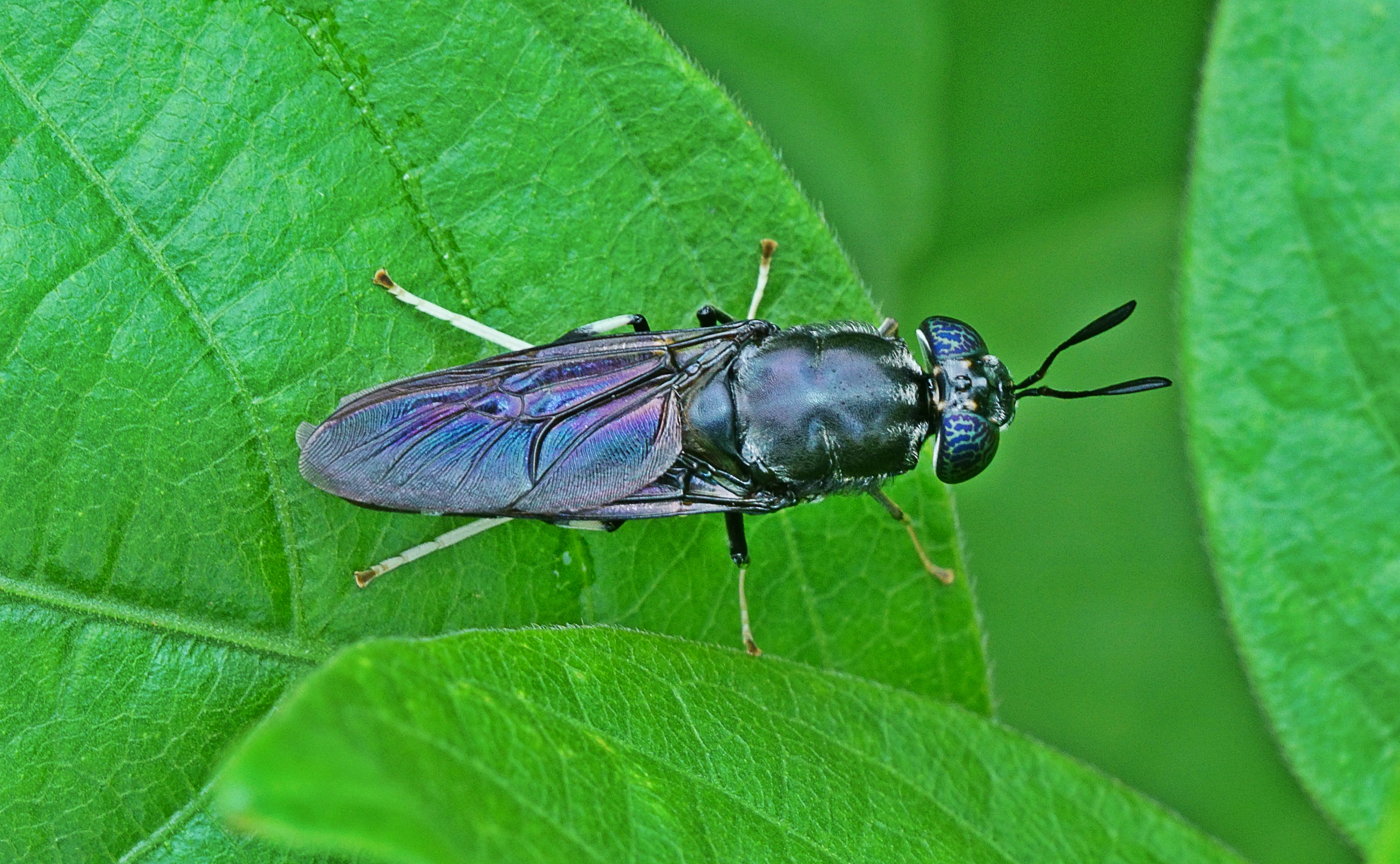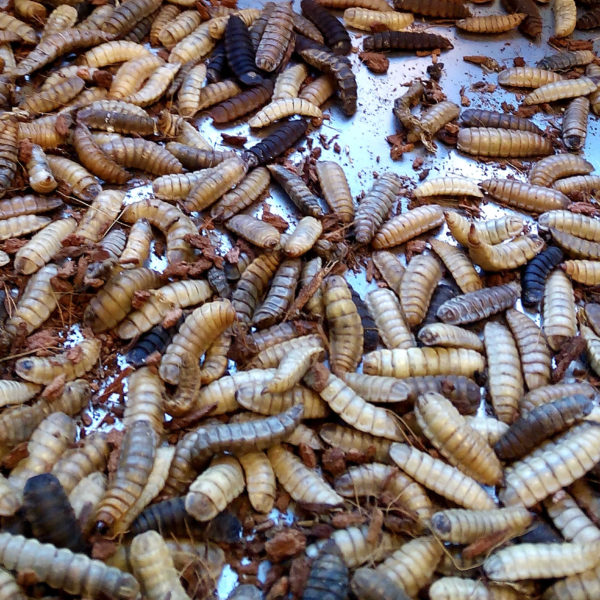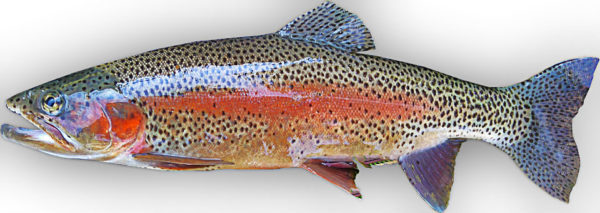
Black soldier fly larvae as fish feed in the EU
09.11.2017 / Scienceandmore / Category: Animal Biology
According to regulation (EU) N° 2017/893, processed animal protein (PAP) from several insect species are approved for the production of feed for animals in aquaculture in the EU. The animals in aquaculture that require ample feed are mainly the following carnivorous and omnivorous fish:
Atlantic salmon (Salmo salar), rainbow trout (Oncorhynchus mykiss), gilt-head seabream (Sparus aurata), European bass (Dicentrarchus labrax), common carp (Cyprinus carpio), and Atlantic bluefin tuna (Thunnus thynnus). In general, a major part of their diet in the wild are other fish and shellfish, but also insects (see previous article).
This article discusses the utilisation of black soldier fly as feed for these fish species. Here, the larval stage shortly before the transition to pupa, i.e. prepupa, is the main development stage that is used for fish feed production, as prepupae contain the highest amounts of protein and fat (egg → larva → pupa → adult fly).
Black Soldier Fly (scientiflcally Hermetia Illucens)
Black soldier flies (BSF) (family Stratiomyidae) are found in tropical and warmer temperate regions. Adult flies are black in colour and of wasp-like shape with a length of approximately 15 to 20 mm. Mature BSF live for approximately 5 to 8 days. During this time they do not take up feed due to their lack of mouth pieces. They solely rely on the storage they built up during their larval stage. The mature female fly can mate after two days and oviposit (laying eggs) quickly after (1). Female BSFs lay more than 500 eggs that makes BSF very interesting in terms of utilisation for the production of animal feed (2). From eggs, whitish black soldier fly larvae (BSFL) hatch that reach an approximate length of 27 mm, width of 6 mm, and weigh of 220 mg as prepupae.

An advantage of BSFL is that they can feed on a wide range of substrates, including food and kitchen scraps, coffee bean pulp, but also other organic wastes such as distillers grains and fish offal, as well as animal manure. A single BSFL can feed on 25 to 500 mg of fresh matter per day, which makes them important decomposers of organic substrates. Due to the quick processing and drying, organic wastes do not tend to emit odour. Subsequently, the residual organic waste could be used as fertiliser since it is still rich in nutrients (1,3). Due to EU legislation, utilisable substrates are restricted and BSFL are not allowed to be reared on manure or food wastes, if they are intended for the production of PAP in animal feed.
In order to optimally rear BSFL, proteins, carbohydrate, fats and a certain structure of the substrate need to be provide. Different ecologically and economically sustainable substrates have been used, such as mixtures that are used for laying hens (mix of maize, wheat, sunflower cake, calcium carbonate, soybean cake, peas, rapeseed cake, rice bran, spelt husks, monocalcium phosphate, soybean oil, sodium chloride, sodium bicarbonate), but also mixtures of cereal processing leftovers (grinding dust, broken pellets and spilled grains), leftovers of distilling processes (dried barley, corn, wheat and sugar syrups), dried sugar beet pulp, and plant compost from tomatoes (4,5,6).
Another advantage of BSFL is their migrating behaviour at the end of their larval stage that can be utilised for collection. The larvae migrate from their humid substrate in order find a dry and protected site for pupation. A self-collection method has been developed by Diener et al. (2011). Here, the larvae climb up a ramp out of the cultivation container and are collected in another container at the end of the ramp (7). However, it has been stated that the utilisation of the migration behaviour does not work as expected, as a uniform migration was not obtained, and a high mortality rate was found due to the artificially high humidity in the substrate. It was concluded that sieving is required for separation of the larvae from their substrate (4).
A disadvantage of BSF is the potentially long period for the larvae to reach their final larval stage. It can last from two weeks up to four months depending on nutrient quality and availability, as well as environmental conditions. For propagation purposes, the subsequent pupal stage can last from 14 days up to 5 months. BSFs and BSFL also require a stable warm and humid environment (between 27 °C and 30 °C, and 50 % to 70 % humidity) that possibly necessitates additional heating and air humidification during cultivation in order to optimise development and growth (1,4,8).
In terms of nutrient content, BSFL contain 40 to 44 % crude protein, which makes them a rich protein source for animal feed. Their fat content can vary greatly and has been shown to depend on the substrate. Oil-rich substrates for example resulted in a fat content of 42 % to 49 %, but also in reduced protein content (1,10).
BSFL are rich in calcium but poor in phosphorus compared to fishmeal (5 % to 8 % of dry matter and 0.6 % to 1.5 % of dry matter, respectively). They have a rather unsuitable calcium:phosphorous ratio for fish feed that, however, could be improved by adding phosphorous. Desired ratios range between 1.1 to 1.4. BSFL have 35 % to 45 % dry matter, which is relatively high and makes it easier to dehydrate them (1,9,10).
Investigations on BSFL as feed for the fish species that are mainly reared in aquaculture in the EU are scarce.

An 8 weeks investigation in the mainly carnivorous rainbow trout (Oncorhynchus mykiss) showed that meal of BSFL could replace 25 % and 50 % of the fishmeal, representing 16 % and 33 % of the total feed (dietary inclusion), without adverse effects on rainbow trout growth and development compared to fish fed with 29 % fishmeal in their diet. The rainbow trout fillets also did not have differences in sensory quality. This, however, was only observed when BSFL were reared on a substrate that consisted of cow manure and fish offal in equal proportions. When BSFL were reared on cow manure only, replacement of fish meal lead to reduced growth of rainbow trout (10). In a 9 weeks study where 25 % of the fishmeal was replaced with BSFL meal, representing 15 % of the total diet, rainbow trout growth was also not affected. Replacement of 50 % of fishmeal, representing 30 % dietary inclusion, however resulted in reduced growth compared to fish fed with fishmeal (36 % dietary inclusion). Here, BSFL were reared on pig manure (10).
Conversely, in an 8 weeks trial where BSFL were reared on tomato plant compost, which would be in compliance with EU legislation, up to 50 % of fishmeal was replaced by BSFL meal without losses in rainbow trout performance or sensory quality (6). These results suggest that the composition of the substrate for BSFL affects their applicability in rainbow trout feed.
These investigations utilised full fat BSFL meal. Two other studies investigated the utilisation of defatted BSFL meal (by mechanical pressure). In an 11 weeks trial with defatted BSFL meal, where BSFL were grown on plant based substrate according to EU legislation, a replacement of up to 50 % of the fishmeal, which represented 40 % dietary inclusion, resulted in similar survival and growth of rainbow trout compared to the fishmeal control diet. Digestibility of the BSFL diet was found to be very good and no alterations of the intestinal morphology of rainbow trout were observed (11). Similarly, in a 7 weeks trial with BSFL reared on food and kitchen scraps (pasta, spent brewer grains, fruit and vegetable leftovers), the defatted meal was used to replace 46% of the fishmeal, which corresponded to 28 % diet inclusion. No differences were observed in terms of weight gain between the replacement diet and the control diet that utilised fishmeal. Also, no significant differences in taste and odour were found between BSFL meal and fishmeal fed rainbow trout. The fillet of BSFL meal fed fish, however, was a little darker in colour (12). Yet, detrimental effects on the fatty acid profile, specifically on the beneficial fatty acids EPA (eicosapentaenoic acid) and DHA (docosahexaenoic acid), were found in rainbow trout when BSFL meal replaced 50 % of fish meal (lipids health indices were also negatively affected). Fatty acid profile differences between control diet and 25 % replacement diet were rather small. It was suggested that the higher amount of fishmeal and therefore fish oil in the 25 % replacement diet provided enough beneficial fatty acids (11).
It could be hypothesised that the fatty acid profile of rainbow trout fed with a 50 % BSFL replacement diet could be improved before butchering by feeding them a finishing diet that contains higher amounts of fishmeal.
In a 15 weeks study with the carnivorous Atlantic salmon (Salmo salar), it was found that a replacement of 25 %, 50 % or 100 % of fishmeal with BSFL meal, representing 5 %, 10 % and 25 % dietary inclusion, performed equally well as the control diet with 20 % fishmeal. Fish of all four groups showed similar growth. The amount of the beneficial fatty acids EPA and DHA was slightly reduced in salmon that were fed with the 50 % and 100 % replacement diet, but not with the 25 % replacement diet. However, fish oil and rapeseed oil were added to all diets, which relativises the fatty acid profile results. Sensory testing of fillets of fish from all four groups yielded no differences. Histological investigations also did not show significant physiological changes. The researchers suggested that the preparation method of BSFL meal could affect performance in fish. When the BSFL meal was highly defatted, salmons showed reduced weight gain with all three replacement diets compared to the control diet that contained 20 % fishmeal (BSFL were reared on human food waste, which would not be approved according to EU legislation) (10,13).
Speculations about the reasons for the observed weight gain differences are hard to make due to the lack of studies in Atlantic salmon.
A 9 weeks investigation in the carnivorous European bass (Dicentrarchus labrax) showed that replacing 20 %, 40 %, and 60 % of fishmeal with BSFL meal in the fish diet, corresponding to dietary inclusion of 6.5 %, 13 % and 19.5 %, did not significantly affect growth and development of the European bass compared to control diet (32 % fishmeal). No palatability issues were observed. This study, however, had a relatively low sampling size of 10 fish per group (14).
In a 10 weeks trial, gilthead seabream (Sparus aurata) were either fed a fishmeal diet with 45 % fishmeal (control diet) or a replacement diet where 10 %, 20 % or 30 % of the fishmeal was substituted by BSFL meal (corresponding to 9.5 %, 19.4 %, and 27.6 % dietary inclusion). Substrate for BSFL mainly consisted of plant based organic wastes. All replacement diets performed worse than the control diet and the replacement diet fed fish showed reduced growth. Palatability of BSFL meal was also found to be reduced. The researchers suggested that the reduced weight gain of gilthead seabream fed with the replacement diets was caused by lower feed consumption due to lower palatability of BSFL meal (15).
Overall, the results of these investigations suggest that BSFL meal can replace fishmeal in parts. The composition of the substrate for BSFL and the fat content of the BSFL meal seem to play crucial roles for the utilisation of the BSFL as fish feed. Research results indicate that plant based substrates and defatting of BSFL meal allow for a higher dietary inclusion without detrimental effects of rainbow trout performance. Atlantic salmon seems to depend much more on a high fat content of the feed for optimal growth and development. European bass appears to manage well with BSFL meal as fishmeal replacement, whereas for gilthead seabream, BSFL meal could be less palatable. It must be noted that the development stages of the fish varied between the mentioned studies. This could be a reason for the different results, since fish at different developmental stages require different diets. In general, the predatory consumption of other fish increases with age. Comprehensive studies across the whole life cycle of fish could shed more light into the applicability of BSFL meal in fish diets.
References
1. Makkar, H.P.S., Tran, G., Heuzé, V., Ankers, P. (2014) State-of-the-art on use of insects as animal feed. Animal Feed Science and Technology. 197:1-33.
2. NCIPMI (1998) Insect and related pests of man and animals. [online] North Carolina Integrated Pest Management Information. Available at: http://ipm.ncsu.edu/AG369/notes/black_sol-dier_fly.html [Accedssed: 02.11.2017].
3. PROteINSECT (2016) Insect Protein – Feed for the Future. [online] Minerva Communications UK Ltd. Available at: https://www.fera.co.uk/media/wysiwyg/our-science/proteinsect-whitepaper-2016.pdf [Accessed: 02.11.2017]
4. Katz (2013) Endbericht zum Forschungsvorhaben „Entwicklung eines Verfahrens zur industriellen Produktion von Präpuppen der Fliege Hermetia illucens zur Futterproteinproduktion. [online] Heretia Futtermittel GbR. Available at: http://www.katzbiotech.de/hermetia/dokumente/Abschlussbericht%20Hermetia%20FuE%20Brandenburg.pdf [Accessed: 03.11.2017]
5. Tschirner, M., Simon, A. (2015) Influence of different growing substrates and processing on the nutrient composition of black soldier fly larvae destined for animal feed. Journal of Insects as Food and Feed. 1(4):249-59.
6. Stamer, A., Wesselss, S., Neidigk, R., Hoerstgen-Schwark, G. (2014) Black Soldier Fly (Hermetia illucens) larvae-meal as an example for a new feed ingredients’ class in aquaculture diets. [Conference paper] Proceedings of the 4th ISOFAR Scientific Conference 2014.
7. Diener, S., Zurbrügg, C., Roa Gutiérrez, F., Nguyen Dang Hong, Morel, A., Koottatep, T., Tockner, K., (2011) Black soldier fly larvae for organic waste treatment – prospects and constraints. [Conference paper] WasteSafe 2011 – 2nd Int. Conf. on Solid Waste Management in the Developing Countries. 13-15 February 2011.
8. Tomberlin, J.K., Adler, P.H., Myers, H.M. (2009) Development of the Black Soldier Fly (Diptera: Stratiomyidae) in Relation to Temperature. Environ Entomol. 38(3):930-4.
9. Tran, G., Heuzé, V., Makkar, H.P.S. (2015) Inserts in fish diets. Animal Frontiers 5(2):37-44.
10. Henry, M., Gasco, L., Piccolo, G., Fountoulaki, E. (2015) Review on the use of insects in the diet of farmed fish: Past and future. Animal Feed Science and Technology. 203:1-22.
11. Renna, M., Schiavone, A., Gai, F., Dabbou, S., Lussiana, C., Malfatto, V., Prearo, M., Capucchio, M.T., Biasato, I., Biasibetti, E., De Marco,M., Brugiapaglia, A., Zoccarato, I., Gasco, L. (2017) Evaluation of the suitability of a partially defatted black soldier fly (Hermetia illucens L.) larvae meal as ingredient for rainbow trout (Oncorhynchus mykiss Walbaum) diets. Journal of Animal Science and Biotechnology. 8, 57.
12. Stadtlander, T., Stamer, A., Buser, A., Wohlfahrt, J., Leiber, F., Sandrock, C. (2017) Hermetia illucens meal as fish meal replacement for rainbow trout on farm. Journal of Insects as Food and Feed. 3(3):165-75.
13. Lock, E.R., Arsiwalla, T., Waagbo, R. (2016) Insect larvae meal as an alternative source of nutrients in the diet of Atlantic salmon (Salmo salar) postsmolt. Aquac Nutr. 22:1202-13.
14. Sánchez López, A. (2015) Potential of pre-pupae meal of the Black Soldier Fly (Hermetia illucens) as fish meal substitute: effect on growth performance and digestibility in European sea bass (Dicentrarchus labrax). Mster thesis. Universitat Politecnia Valencia.
15. Karapanagiotidis, I.T., Daskalopoulou, E., Vogiatzis, I., Rumbos, C., Mente, E., Athanassiou, C.G. (2014) SUBSTITUTION OF FISHMEAL BY FLY Hermetia illucens PREPUPAE MEAL IN THE DIET OF GILTHEAD SEABREAM (Sparus aurata). [Conference Paper] HydroMedit 2014, November 13-15, Volos, Greece.
